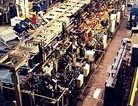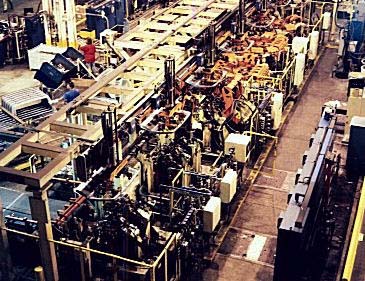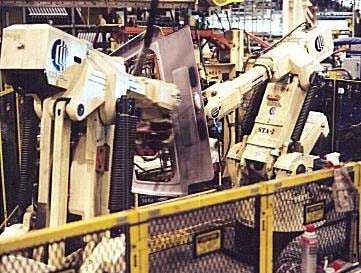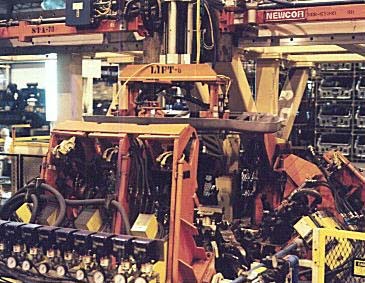In a Switch SUV Lift Gate Redesigned in Rugged Steel

While the usual trend in designing automotive parts is to redesign them in lighter materials such as fiberglass, aluminum, or plastic to save weight or because of corrosion concerns, an auto lift gate that was originally produced in plastic has been replaced with a more rugged steel part. The reason is the need for structural stiffness in the auto part.
Tower Automotive (Elkton, MI) is a Tier One automotive supplier that produces the final assembly from stampings. For the assembly of the finished parts, Tower had a unique manufacturing line designed using robots, non-contact laser gaging, and a HY-PAK welding line to maintain a Class A surface finish on the metal.

Since the part was new, Tower had to develop a line to produce 112 parts per hour. To produce an integrated assembly line with welding, Tower turned to Newcor Bay City Division (Bay City, MI) to design, engineer, and produce the integrated part assembly system.
Marrying two stampings
Two stampings were used—one for the outer lift gate and one for the inner panel— to develop the necessary structural integrity. Before they are married together, several reinforcement brackets are welded to the inner panel across several stations. Sharp dimple projections (for the HY-PAK welding) are also added. At the same time, the outer panel is loaded onto the line and picked up by a robot. The robot holds the part and maneuvers it while a second robot applies a bead of two-part epoxy adhesive in various areas around the panel. The part manipulation robot twists it in four different axes keeping it level to the floor to reduce adhesive sag. The robot then presents the panel for the application of anti-flutter adhesive dollops.

One of the processes that Newcor uses is a Perceptron laser system, mounted on the adhesive dispensing robot, to measure the thickness and quality of the bead and to make sure there are no gaps in it. The seam is measured for both height and width to a tolerance of at least ±1 mm. If there is a problem with the bead, an alarm is triggered to alert the operator to make corrections.
After the sealant is applied to the outer panel it is placed in a setup jig. There an operator manually marries the inner panel. Then the part is transferred with an overhead pick-and-place unit through the rest of the system where the inner and outer panels are hemmed together and then welded using a conventional spot welding system in areas that don't require a critical surface finish. In critical surface finish areas, Newcor's patented HY-PAK system is used to achieve a Class A, non-blemished surface. After welding, the part is unloaded to an operator for visual inspection and then placed in a shipping rack.
The entire dedicated line comprises 15 different stations. Galvaneal 1010 and 1008 steels are used for the parts. The line offers some flexibility to produced components with minor tool modification. However, the system is intended to serve long-term part production requirements.
HY-PAK projection welding
Newcor's HY-PAK welding system is a patented resistance welding process that uses a combination of a high-energy, short duration, unidirectional pulse with rapid electrode follow-up. The duration of the weld current pulse is so short that the high current is concentrated at the weld point and minimal heating is transmitted to the adjacent component and electrode material.
HY-PAK is an extremely fast process that causes minimal disruption of protective coatings while reducing coating pickup on electrodes. It eliminates component damage for lightweight materials by using lower welding forces. Because the process does not build up heat in base materials and electrodes during welding, protective material coatings are not burned off and a Class A surface is left for immediate painting or coating without any secondary finishing.

To use the HY-PAK welding process on the panels, a sharp linear projection is produced on one of the panels where the weld takes place. The key to success using HY-PAK is to do the resistance weld very quickly with the help of a very sharp projection. This arrangement localizes the heat, creating a weld in a very short period of time. The sharper the projection, the easier it is to accomplish that goal.
Newcor designed the process line to put the projections in the parts for the HY-PAK process instead of adding them in the stamping process. By doing it this way, they've found that the quality of the projection is much better because the location of the projection can be adjusted, and the dimensions of the projection can be easily controlled. Also, if the punch and die set needs changing, it's easier to do it on the assembly line. If one of the punches breaks, it can be detected quickly because the weld quality is immediately noticeable. On a stamping line, thousands of parts can be made with poor missing projections before being noticed.
According to Merlin Farver, chief engineer, without the HY-PAK weld, the inner and outer panels would shift no matter how tightly they squeeze the hems together in the hemming process. Newcor's HY-PAK welding process ensures that the panels stay in relative position to each other and produces an unblemished surface after the weld to eliminate any post processing of the metal before painting.
The line runs on-demand primarily, but if needed they will run it around the clock, depending on components parts or Tower's schedule. Normally, we'll produce about 15,000 to 20,000 parts a month," says Farver.
What's important with the part is repeatability, says Farver. Panel tolerance is 0.5 to 0.75 mm. All aspects of the panel itself are checked. "We collect dimensional data and provide it to the customer. We track the dimensional tolerances of the part so we know if there is a problem with consistency. We can identify the problem during manufacturing and make the appropriate adjustments to maintain proper specifications."
Information for this article supplied by Newcor Bay City Division, 1846 Trumbull Drive, Bay City, MI 48707; phone: 517-893-9505
